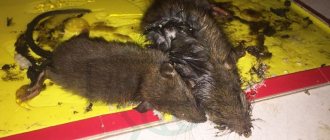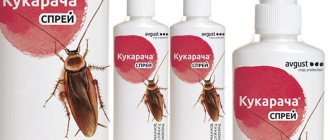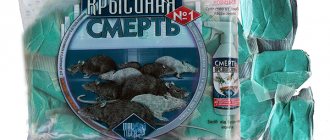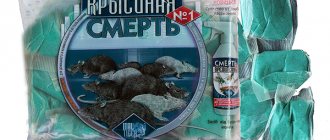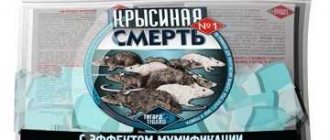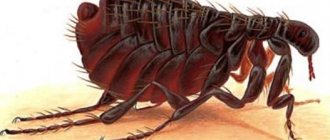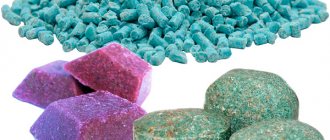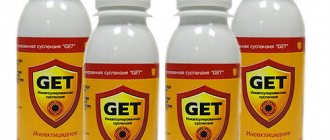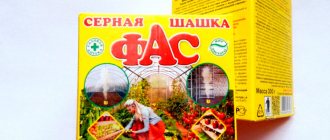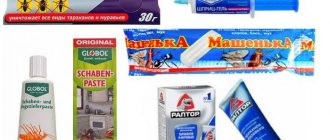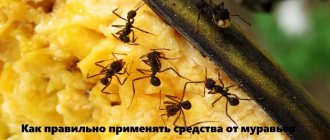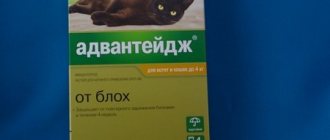The appearance of a tailed house is not only an unpleasant phenomenon, but also dangerous. Therefore, as soon as the first pests were noticed, you need to start a war with them. Rat Death poison is effective in killing rodents. It is designed for large-scale pest control in apartments and private sectors. The poisonous drug is produced by Dr Tezza, an Italian company that has offices in other countries.
The appearance of rats in the house is a big problem, so you need to resort to a number of methods to exterminate them
Composition of the drug
The drug is available in two types - Rat Death 1 and 2. They differ in the active ingredient. Composition No. 1 includes brodifacoum, and No. 2 contains bromadiolone.
Even a small dose of brodifacoum is enough to poison the pest, since the component is very toxic. The action of bromadiolone is much slower, but its results are impressive. The first drug has a blue-green color, the second is available in the form of meat pieces.
This video talks about ultrasonic rat repeller:
Additional components of the poisonous drug are:
- nutritional supplements;
- Wheat flour;
- flavorings;
- sunflower oil.
The poison does not reveal itself at all. The tailed animals eat the treat with appetite. The product does not begin to act immediately, so the rats do not see anything suspicious in the bait. You need to constantly add poison and wait for the result.
Mode of application
Use of poison
The drug Rat Death is used to exterminate rodents by residents of private houses and by independent special teams involved in deratization. The poisonous substance is placed in plastic or cardboard containers so that they cannot be reached by pets or children.
Rat poison is placed in the most likely locations for rodents:
- near the burrows of mice and rats;
- on the path of their movement;
- along the walls of utility and living spaces.
Release form
The effectiveness of the drug mainly depends on the form of release. The gel-like mixture in the form of a briquette is packed into a filter and placed in film. The shelf life of such a package is 3 years.
Read on topic:
Sulfur ointment: instructions for use, price and reviews
15.10.2019
Get Total - a modern means for effective control of insects
25.06.2019
Getting rid of cockroaches and bedbugs with Xulat Micro
25.06.2019
Xulat C25 - a powerful modern remedy for cockroaches and bedbugs
25.06.2019
The “Rat Death” poison has a gel structure and a long shelf life
The gel base of the drug has its advantages. It does not allow the poison to lose its properties even when exposed to sunlight and high temperatures. An open briquette can be used within 14 days.
The rat poison Rat Death is not difficult to purchase in any store; its cost is quite reasonable. The package consists of 8 briquettes of 100 g or 16 of 200 g.
Due to its active composition, as well as the release form, which allows the poison to not lose its properties for a long time, the poison is in demand compared to its analogues.
Features and types of rodenticide
Rat poison (rodenticide) is one of the most radical means designed to combat rats.
Poison is a mixture based on chemicals. There is no clear answer to the question of what rat poison looks like. The poison can be produced in various forms in the form of tablets, granules, briquettes and pastes. When used, a poisonous drug is mixed with bait and placed near burrows or in places where rats may appear. Using rodenticide Based on the type of action, rodenticides are divided into:
- Chronic rat poisons. They do not pose a risk to the health of pets, as they are used in small doses. This is why they have a delayed effect. Therefore, the destruction process using this method will take some time. But despite this, rodenticides of this type are much more effective. After all, rodents do not combine the death of their relatives with eating poisoned bait.
- Acute rat poisons have an immediate effect on rodents. Suspecting the relationship between death and the delicacy of the bait, the rats try to avoid the poison. And besides, rodenticides of this type pose a great danger to the health of pets. Fast-acting poisons are prohibited for free sale and can only be used by professional rodent extermination services.
Rodenticides can also be anticoagulants and have a mummifying effect, according to manufacturers. A feature of the second type of drugs is not only the ability to destroy, but also the mummification of the carcass of a poisoned animal, which eliminates the unpleasant stench.
Anticoagulants do not have similar properties. However, they are much more effective than drugs of the previous type and are safer for human health and pets. Commercially available rat poison contains substances that cause blood clotting disorders (zoocoumarins). The penetration of poison into the animal’s body causes internal bleeding. Rat poison Rat repellents are in great demand among the population:
- Warfarin (Zookoumarin);
- Ethylphenacin;
- Izoindane;
- Ratindan and others.
They act slowly, without accumulating in the body. Sometimes pests develop immunity to them.
Difenacoum, Brodifacoum, Flocumafen, Bromadiolone are more toxic second-generation anticoagulants. They have a quick action and cumulative effect.
Action of a toxic substance
Instructions for use of Rat Death and reviews speak about one thing: this is truly one of the best drugs on the modern market.
How does the poison Rat Death work: the active components brodifacoum and bromadiolone are anticoagulating rodenticides. When they enter the tailed liver, it stops producing vitamin K and the blood stops clotting. As a result, bleeding occurs in the rodents' body.
If a rat consumes a large dose at one time, it will die within 3 days, but if the poison enters the body in small portions, then death will occur within a week. The poison accumulates in the body and is not excreted in the urine. Therefore, when its content reaches a fatal level, internal bleeding begins.
The drug is not addictive, unlike first-generation poisons. The lethal dose for mice from Rat death number 1 is 0.24 g, and for rats - 2 g. To kill a mouse with poison number 2, 0.6 g of the drug is required, rats need 6 g.
A rat eats 50 g of food per day, and a mouse only 5 g. Therefore, the probability that a lethal dose will be received in a day is quite high.
How does the product work?
It is easy to understand how the poison affects rodents by studying the composition of the drug. On the fourth day, rodents that have consumed the poison begin to experience suffocation. Internal bleeding begins. Because of it, the animal dies on the 8th day.
"Rat Death No. 1"
How to use?
In order not to leave a human smell on the poison, which can scare off a rodent, the drug is put into bags for mice using tweezers. If it is used as poison for rats, then 2-3 bags of poison will be required. It should be placed in places close to rat nests and their habitats. In residential premises, it is better to spread it along the walls every 2-15 m. For two weeks, you need to monitor the decomposed poison and replenish it where it is eaten. When the pests stop eating the poison, you can stop spreading it.
The death of rodents will occur 4 days after its consumption. 10 days is the final period for the full effect to occur.
Everything that remains after poisoning pests (remains of poison, boxes, bags), as well as their corpses, must be burned.
Terms of use
The instructions clearly describe all the rules that should be followed. Their violation can lead to negative consequences and harm human health.
Mode of application:
- First, you should choose a place where to place the bait: rodents should notice it immediately. Then prepare palm-sized stands made of cardboard (you can also use tin lids).
- Prepare tweezers and toothpicks, put on gloves.
- Then take out the package with the poison and place it, without unfolding, on the stands. Mice need one serving, rats need two briquettes.
- Treats should be placed near burrows and in places where rodents move. For effective destruction, briquettes are placed at a distance of 2 to 5 meters from each other for mice and from 5 to 15 meters for rats.
Pest activity occurs at night, so every morning you need to put a new briquette in place of the one eaten.
After all the rodents have been exterminated, you will need to collect the poison that remains intact in a bag and bury it to a depth of 0.5 m. Under no circumstances should you throw the remains into the trash can, because cats, birds and yard dogs can eat them. The corpses also need to be buried so that the animals do not get poisoned by them.
"Rat Death": instructions for use
The poison "Rat Death" is completely ready for use. This is another advantage of this product. There is no need to dilute or mix the poison significantly reduces the risk of human intoxication. However, before resorting to poison, be sure to familiarize yourself with some important points.
Safety precautions
Working with toxic drugs and substances should begin with careful study of the instructions. When using a rodenticide, strictly adhere to the six safety rules.
- Briefing. The use of the drug by persons under 18 years of age, pregnant or lactating women is strictly prohibited. Working with anticoagulants is contraindicated for people suffering from liver or blood diseases.
- Informing. Persons living in the area, including neighbors (if destruction is carried out in an apartment building), must be warned about the work being carried out in order to eliminate the risk of accidental poisoning.
- Removal of children and pets. Small children and pets should be temporarily evacuated from the treated area, since it is very difficult to completely protect them.
- Means of protection. Carry out all work in special clothing and rubber gloves, completely avoid skin contact with the product. Place baits with tweezers or use a plastic spoon.
- Eating food. It is strictly forbidden to eat anything, drink any drinks or smoke while the premises are being treated.
- Cleaning. Removing rodent corpses and poison residues is only permitted while wearing rubber gloves. Both dead rats and exposed poison bricks should be burned or buried in the ground to a depth of at least 1 m.
Never throw poison residues or poisoned rodent carcasses into a regular trash container. Stray dogs, cats or birds are able to profit from such a find.
5 processing steps
Having taken all safety measures, you can begin baiting rodents. The poison “Rat Death” is used both in residential premises and in outbuildings. It can even be spread out in the garden if tailed pests have targeted your vegetables and fruits. The usage algorithm includes five steps.
- Preparing the base. Cut regular cardboard into 10x10 cm squares. Place them in different places.
- Opening the package. Arm yourself with tweezers, and only then unpack the package of poison. Using a tool, remove the filtered bag.
- Laying out the poison. Do not open or puncture the packaging - rodents will cope with this task themselves. Carefully place the briquette on the cardboard. If you are laying out bait for mice, then one filter bag is enough; if you are fighting rats, then place two briquettes on each piece of cardboard. The distance between the baits depends entirely on what rodents you are fighting: 2-5 m is enough for mice, and 4-15 m for rats.
- Replacement of eaten briquettes. Since rodents are active at night, check the condition of the baits in the morning. Place new briquettes in place of the eaten briquettes. Continue until all baits remain intact.
- Destruction of remains. Wearing rubber gloves, collect the briquettes and dispose of any unspent poison.
Security measures
If the poison is handled correctly, it is not capable of harming a person. When working, you should use rubber gloves and avoid touching your face. When finished, throw them away and wash your hands well with soap.
After handling rat poison, you should wash your hands thoroughly under running water.
The components of the drug do not volatilize, therefore, do not affect animals and people. A negative reaction is possible only if it enters directly into the stomach. The danger may arise from eating poison, so the drug should be kept out of the reach of children.
Symptoms of poisoning: loss of consciousness, nosebleeds, irregular pulse, nausea, red urine and stool, headache and blood on the gums.
The antidote is Vikasol and vitamin K. They are administered intravenously for 2-4 weeks. The consequences depend on age, immunity, the presence of other diseases, and the condition of the person’s kidneys and liver. Only timely medical care can save you from death.
This is interesting: a homemade way to catch a rat in the house.
Providing assistance in case of poisoning
It is almost impossible to get poisoned by the drug Rat Death by inhaling its smell, since it has no odor. But if handled carelessly, the product may end up in:
- on the skin;
- into the stomach.
If the drug gets into the gastrointestinal tract, you should immediately induce vomiting, take activated carbon in the amount of 10-20 tablets and a saline laxative (1 tablespoon of Glauber's salt per glass of water). In case of contact with skin, wash the contaminated area with soap or a 0.2% solution of potassium permanganate. After the assistance provided, you must go to a medical institution, where the victim will be examined and vitamins of group “K” will be given as an antidote to this poison.
